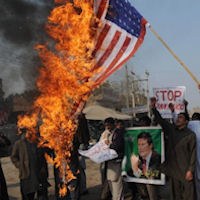![]()
First published in The Meir Amit Intelligence and Terrorism Information Center’s bulletin number 162.
The appointment of Tehran’s former attorney general Sa’id Mortazavi to director of the Social Security Foundation has stirred a political controversy this week due to his involvement in the Kahrizak detention facility affair. The incident broke out in July 2009, when the south Tehran detention facility was closed down on the Supreme Leader’s orders in light of reports according to which at least three detainees had died in the facility as a result of torture and abuse from wardens and criminals with whom they were detained. One of the detainees who died in the detention facility was Abdolhossein Ruholamini, the son of a top advisor to Mohsen Reza’i, secretary of the Expediency Discernment Council and former commander of the Revolutionary Guards.
In August 2009 the Iranian authorities were forced to admit that some of the people detained in the riots that broke out after the presidential elections had died in the detention facility as a result of being held in bad conditions. A parliament inquiry committee appointed to investigate the events put the responsibility for the affair on Sa’id Mortazavi, who had decided to relocate approximately 150 people arrested in the riots that broke out after the presidential elections to Kahrizak, which was originally planned as a detention facility for dangerous criminals and drug addicts.
In 2003 Mortazavi was also involved in the death of Zahra Kazemi, a Canadian journalist and photographer of Iranian descent, who died in Evin Prison after being arrested by the internal security forces. Her death was apparently due to torture she underwent during questioning. The Canadian government, which investigated the incident, claimed that Mortazavi was involved as a judge in summoning Kazemi for questioning and in the questioning itself, and was even present when she died. In his different judiciary capacities, Mortazavi was also responsible for shutting down dozens of pro-reformist newspapers and arresting journalists and bloggers.
Following the Kahrizak incident, Mortazavi was removed from his position as Tehran’s prosecutor general. In 2010, however, he was appointed chief of the government headquarters for the prevention of smuggling goods and foreign currency.
Mortazavi’s appointment as chief of the Social Security Foundation drew strong criticism from the political system. A number of Majles members announced that, following the appointment, they launched a move intended to remove from office Abdolreza Sheikholeslami, the minister of welfare and social services. Majles member Parviz Sorouri said in an interview to Mehr News Agency that Mortazavi is absolutely not fit for his new position, and that if he does not resign willingly, the Majles will take action to impeach the welfare minister. He noted that the Social Security Foundation is one of Iran’s most sensitive, important, and influential economic institutions, and that it has no place for individuals lacking executive experience (Mehr, March 17). Thirty-two million Iranians use the services of the Social Security Foundation, which has seen six directors in as many years.
Ahmad Tavakoli, chairman of the Majles Research Center, also criticized the appointment, saying it will be a problem for both Mortazavi and the minister of welfare and social services (Bultan News, March 17). The appointment was also criticized by Majles member Fatemeh Ajorlou, who referred to it as highly surprising and said that Mortazavi is a person with a problematic background who had abused his powers as Tehran’s prosecutor general. She further added that the Majles members intend to seriously look into the appointment after the Nowrooz holiday (Fars, March 18).
Approximately two weeks ago fifteen Majles members asked President Ahmadinejad to refrain from appointing Mortazavi due to his lack of qualification for the position and his involvement in the Kahrizak incident. The families of several political prisoners who died in prison after the 2009 riots also protested the intent to appoint Mortazavi for the key economic role.
The Parsineh website said this week that the president’s decision to appoint his close ally Mortazavi as head of the Social Security Foundation was intended as a provocation to his political opponents in the conservative camp and to judiciary chief Sadeq Larijani, who removed Mortazavi from his position as Tehran’s prosecutor general (Parsineh, March 17). Fars News Agency also said that it was the president himself who decided on Mortazavi’s appointment, and that the “deviant faction” (a term used to refer to the faction affiliated with the president and his office chief Rahim Masha’i) was involved as well. According to Fars, even the welfare minister was opposed to the appointment (Fars, March 18).



 RSS
RSS











Latest Comments
Hello Mike, Thank you for your positive feedback to the article. I felt there wasn’t too much critical analysis of ...
Thanks for this considered and well constructed article. A follow up article on the manner in which the editorial contro...
THE CLUELESSNESS OF CLAIMING THAT OBAMA'S MIDDLE EAST POLICIES WERE A FAILURE CANNOT BE FURTHER FROM THE TRUTH, WHAT THE...
As long as Obama is the president of the usa do not trust the us government......
Thank you for an good read....